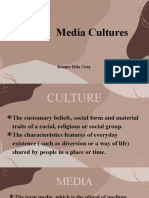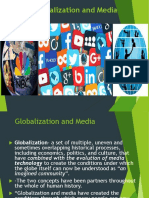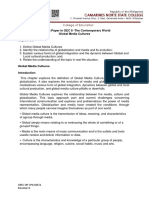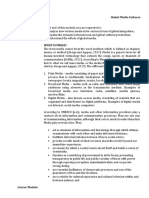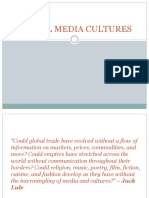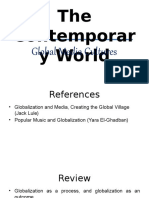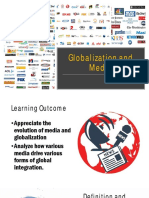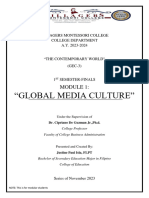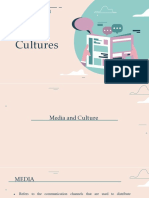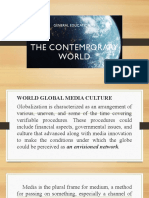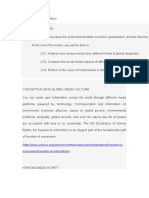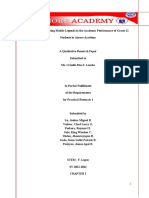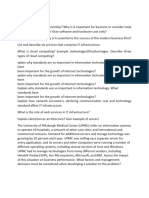Course Number: GE 06
Course Title: Contemporary World with Peace Control
Module Number: 6
Overview:
This module introduces students to understand, analyze,
and evaluate the contemporary world by examining the multifaceted
phenomenon of globalization, among which are the economic, social,
political, technological, and other phenomena that have created an
increasing awareness of the interconnectedness of peoples and places
in the global community. It also tackles the greatest resource for
building a culture of peace for the people themselves, for it is through
them that peaceful relationships and structures are created.
Module Outcome
At the end of the module, the students must have:
analyzed how various media drive various forms of
global integration;
explained the dynamic between local and global
production;
understood the effects of global media.
GLOBALIZATION:
� A
World
INTRODUCTI
ON
A world of
of Idea introduces learners to import
thinkers
throughout
King.
whose
Ideas ideas have shaped civilizations
history – from Plato to Martin Luther
What is Media?
The term media comes from the word medium which is defined as channel, means,
or method (Aboga and Agapay, 2017). Media is a generic term for all human-
invented technology that extends the range, speed, or channels of communication.
The means of communication, as radio and television, newspapers, magazines,
and the internet.
EVOLUTION OF MEDIA AND GLOBALIZATION
To understand further the study of globalization and media, it is important to
appreciate five periods of the evolution of media and globalization.
1. ORAL COMMUNICATION
Language allowed human to corporate.
It allowed sharing of information.
Language became the most important tool as human being explored the
world and experience different cultures.
It helped them move and settle down.
It led to markets, trade and cross-continental trade.
2. SCRIPT
Page 1
� Language was important but imperfect; distance became a strain for oral
communication.
Script allowed human to communicate over a larger space and much longer
times.
It allowed for the written and permanent codifications of economic, cultural,
religious, and political practice.
3. THE PRINTING PRESS
It started the “information revolution”.
It transformed social institutions such as schools, churches, government and
more.
Media consisting of paper and ink, reproduced in a printing process that is
traditionally mechanical. Examples of print media are: newspaper, books,
magazines, comics, brochures.
Elizabeth Eisenstein (1979) surveyed the influences of the printing press.
o It changed the nature of knowledge. It preserved and standardized
knowledge.
o It encouraged the challenge of political and religious authority
because of its ability to circulate competing views.
TYPES OF NEWS AGENCIES
1. Transnational/world news agencies
Transnational news agencies operations are on a world wide scale.
They maintain correspondents or reporters in almost all the major cities
around the world.
Examples- Associated Press (AP) in United States, United Press International (UPI) in
US, Reuters in Britain, Agence France Press (AFP) in France, TASS in Russia.
2. The Continental/Regional News agencies
It operates within their continents or regions.
They may have correspondents and subscribers in other countries of
the world, but their service and operations are not spread to every part
of the globe.
These news agencies are not as rich as the transnational or world news
agencies.
3. The National News Agencies
Almost, every country in the world has one form of news agency.
It is worth noticing that several national agencies because of their
global reach do not fall under this category.
Page 2
� National news service only see serve their individual countries while
the AP, UPI, Reuters and AFP serve the world.
4. Electronic or Broadcast Media
The vast reach of these media continues to open up new vistas in the
economic, political, and cultural processes of globalization.
Radio- quickly became a global medium, reaching distant regions.
Television- considered as the most powerful and pervasive mass
medium. It brought together the visual and aural power of the film with
the accessibility of radio.
The electronic media and communication sector, which ranges from
telecommunication networks and the internet, through to radio,
television and film, is itself among the most active in the current drive
for the globalization of production, market and trade.
Media such as radio and television that reach target audiences using
airwaves as the transmission medium. Examples of broadcast media
are: television, radio, satellites, mobile phones, movies/films.
5. Digital Media
Digital media are often electronic media that rely on digital code.
Many of our earlier media such as phones and TV’s are now considered
digital media.
In the realm of computer it allowed citizens to access information from
around the world.
Also known as new media, consisting of contents that are organized
and distributed on digital platforms. Examples of digital media are
internet, social media, and computers.
What does Media do for
us?
Mass media plays a key role in extension of globalization process. The
media components such as television, internet, computers etc. are
considered to have a paramount influence on globalization; radio is one of
the easiest and cheapest media sources.
Media fulfills several basic roles in society. One obvious role is
entertainment. Media can act as a springboard for our imaginations, a
source of fantasy, and an outlet for escapism.
Media can also provide information and education. Information can come
in many forms, and it may sometimes be difficult to separate from
Page 3
� entertainment. Today, newspapers and news-oriented television and radio
programs make available stories from across the globe, allowing readers
or viewers in London to access voices and videos from Baghdad, Tokyo, or
Buenos Aires. Books and magazines provide a more in-depth look at a
wide range of subjects.
Another useful aspect of media is its ability to act as a public forum for the
discussion of important issues. In newspapers or other periodicals, letters
to the editor allow readers to respond to journalists or to voice their
opinions on the issues of the day.
GLOBALIZATION AND MASS MEDIA
Before the 1990s, most mainstream media were national in scope, since then
most communication media have become increasingly global.
International flows of information have been assisted by the development of
global capitalism, new technologies and the increasing commercialization of
global television, and which have occurred as a consequence of the deregulation
policies adopted by various countries in Europe and US, paving the way for the
proliferation of cable and satellite channels.
Rapid expansion of global communications can be traced back to the
mechanical advancements of the technologies during the 18 th/19th centuries,
which began with the invention of the telegraph in 1837, and included the
growth in postal services, cross-border telephone and radio communication and
the creation of a modern mass circulation press in Europe.
GLOBAL MEDIA CULTURES
The objective of the research programme is to undertake an extensive and
focused analysis of the ways in which media cultures take part in processes of
globalization, including how they challenge existing cultures and create new and
alternative symbolic and cultural communities
The media have a very important impact on cultural globalization in two
mutually interdependent ways: Firstly, the media provide an extensive
transnational transmission of cultural products and, secondly, they contribute to
the information of communicative networks and social structures. The rapidly
growing supply of media products from an international media culture presents
a challenge to existing local and national cultures. The sheer volume of the
supply, as well as the vast technological infrastructure and financial capital that
pushes this supply forward, have a considerable impact on local patterns of
cultural production. Global media cultures create a continuous cultural
exchange, in which crucial aspects such as identity, nationality, religion,
behavioral norms and way of life are continuously questioned and challenged.
These cultural encounters often involve the meeting of cultures with a different
Page 4
�socio-economic base, typically a transnational and commercial cultural industry
on one side and a national, publicly regulated cultural industry on the other side.
Due to their very structure, global media promote restructuring cultural and
social communities. The media such as the press, and later radio and TV have
been very important institutions for the formation of national communities.
Global media support the creation of new communities. The internet, for
example, not only facilitates communication across the globe, but also supports
the formation of new social communities in which members can interact with
each other. And satellite TV and radio allow immigrants to be in close contact
with their homeland’s language and culture while they gradually accommodate
to a new cultural environment. The common point of departure is the
assumption that a series of international media constitutes a global cultural
supply in itself and serves as an independent agency for cultural and social
globalization, in which cultural communities are continuously restructured and
redefined.
What role do the media play in the rush towards
globalization?
To some, globalization means the transfer of ideas and culture form the
developed west to the undeveloped world, resulting in a homogenization of
consumerist culture across borders that threaten to disrupt and permanently
alter indigenous values. Yet others might suggest that the flow of ideas occurs
in multiple directions, resulting in less homogenization and more diversification
of ideas and lifestyles.
Even these general models mask the true depth and complexity of the global
reach of media. What is certain is that globalization has greatly expanded the
importance of what information lies within the “public sphere,” and the sharing
of that information will undoubtedly continue to have an effect both on the lives
of private individual’s vis-à-vis their relationships with each other, and the
nations-states they live in.
Most theorists agree that there is practically no globalization without media and
communications, as many of the definitions of globalization at least indirectly
acknowledge. The role of media and communications is, of course obvious in
globalization theories, but it is not necessarily visible. This causes problems in
two ways. First the role of media and communications in globalization theories
remain vague and unspecified. Secondly media studies missed the ‘big picture’
of globalization and have been contributing little to theoretical discussions on
globalization.
Page 5
� VARIOUS FORMS OF GLOBAL INTEGRATION
What is Global Integration?
Global integration is the degree to which the company is able to use the
same products and methods in other countries. Local responsiveness is
the degree to which the company must customize their products and
methods to meet conditions in other countries.
Global integration is not a new phenomenon in today’s contemporary
world. Trade took place between distant civilizations even in ancient
times. This globalization process in the economic domain has not always
proceeded smoothly has it benefited all whom it was offered, but, despite
occasional interruptions, such as the collapse of the Roman Empire or
during the interwar period in this century, the degree of economics
integrate among different societies around the world has generally been
rising in the past half century, and ever greater that it has been and is
likely to improve.
There are three (3) factors that have affected the process of economic globalization.
These are:
1. Improvement in transportation and communication technology have reduced
the cost of transporting goods, services and factors of production and
communicating economically useful knowledge and technology.
2. Tastes of individuals and, societies have generally but not universally, favored
taking advantage of the opportunities provided by declining costs of
transportation and communication through increasing economic integration.
3. The character and pace of economic integration have been significantly
influenced by public policies, although it is not always in the direction of
increasing economic integration.
Thus, technology, tastes, and public policy each have important influence on the
pattern and pace of economies in its various dimensions.
DYNAMICS BETWEEN LOCAL AND GLOBAL CULTURAL PRODUCTION
At the beginning of the new century culture is exposed to a radical change all
over the world. Those whose education or wealth allows them to partake fully in
the advantages of a globalized culture and economy tend to have a positive
attitude towards these developments. On the other hand, there are strong local
movements, especially in the Third World, which reject the project of
globalization as essentially destructive of all the values they hold dear. They
Page 6
�see globalization as an extension of colonization, with its concomitant
destruction of local moral values and ways of knowing. Yet many of the “local”
traditions are constructs invented by the ethnologists of the colonizers, and
retention of these imaginary “traditions” involves a limitation of growth and
cultural development. Creative cultural energies are attracted to the centers
(Western Europe, the USA, Japan), thus allowing them to generate cultural
surplus, while at the same time destroying indigenous cultures worldwide.
Paulo Emanuel Novais Guimaraes pointed out that the advent of the category
‘world music’ led to both an unprecedented level of (re) discovery of local
music scenes and to an assemblance of an intricate global musical platform in
the contemporary age of globalization. The processes in which local cultures
express and engage themselves with boarder global networks and the other
way around can be claimed to be indispensable sources of knowledge in the
analytical approach of socio-political concerns, these being of small or large-
scale societies. Extremely frequent in debates on globalization is after all the
dichotomic struggle between the concrete and human ‘local’ against the
abstract and dehumanizing ‘global’ (Wilson & Dissanayake, 19966:22). In order
to apprehend how this relationship has indeed been marked at times by
oppression and domination, the critical theoris of auithors such as Wdward
Said, Homi K. Bhabhaand Immanuel Wallerstein will be applied to cases of local
and global music industry. This lesson aims nonetheless; above all, to provide a
concise yet consistent introduction to hoe this relation goes beyond the
criticisms of cultural imperialism and Americanization, to how multifarious this
relation can be. Key issues represented by the binary concepts of authenticity
and homogeneity and of production, distributions and marketing of cultural
products, will be referred to. Without trying to uphold a modernocentric view
that admits the rise of globalization as a recent phenomenon, the commercial
dynamics between the global and local in world music approached, will be
mostly from the 1950’s onwards.
Page 7
�SUMMA
RY
To understand further the study of globalization and
media, it is important to appreciate five periods of the
evolution of media and globalization.
Mass media plays a key role in extension of globalization
process. The media components such as television,
internet, computers etc. are considered to have a
paramount influence on globalization; radio is one of the
easiest and cheapest media sources.
Rapid expansion of global communications can be traced
back to the mechanical advancements of the technologies
during the 18th/19th centuries, which began with the
invention of the telegraph in 1837, and included the
growth in postal services, cross-border telephone and radio
communication and the creation of a modern mass
circulation press in Europe.
Global integration is the degree to which the company is
able to use the same products and methods in other
countries. Local responsiveness is the degree to which the
company must customize their products and methods to
meet conditions in other countries.
Page 8
� ACTIVITY
Direction: Make a Slogan that shows/tells about the impact of
globalization on media vice-versa. Then explain your work.
Slogan rubrics
Content 10
Creativity 10
ASSESSM
ENT
IDENTIFICATION
Direction: Identify the following statements
1. It is the degree to which the company is able to use the same products and
methods in other countries.
2. These are often electronic media that rely on digital code.
3. It operates within their continents or regions.
4. It transformed social institutions such as schools, churches, government and
more.
5. It allowed human to communicate over a larger space and much longer times.
ESSAY
Page 9
�I. Direction: Read carefully the instructions below. Discuss the following
questions comprehensively.
1. What is global media culture?
2. How do the media affect cultural globalization?
3. Is it possible for globalization to occur without media? If YES, why? If NO,
why not?
II. Write an essay consisting of 300-500 words. The topic is: “My Role as a
Citizen in Promoting Peace and Order in the Community.”
CRITERIA 5 4 3 2
REFERENCES The essay is The essay is The essay is The essay
focused, focused on the focused on the poorly
purposeful, and topic with topic with addresses the
FOCUS(Main reflects clear relevant ideas. loosely related topic with
Point) insights and ideas. irrelevant
ideas. ideas.
Effectively Organize ideas Some Little or no
organize ideas to build an organization of organization of
in a logical and argument. ideas to build ideas to build
ORGANIZATIO coherent an argument. an argument.
N OR FORMAT argument
Distinctive Sufficient Very little No
experimentation experimentatio experimentatio experimentati
of language and n of language n to enhance on or
ORIGINALITY usage to and usage to the concepts. enhancement
enhance enhance of concepts.
concepts. concepts.
Chapter IV: Peace Education: A Transformative Response To Major Societal
Challenges
The Contemporary World by; Lisandro E. Claudio and Patricio N. Abinales
The Contemporary World by; Dr. M. Ariola, LLB. , Ed.D. , L.P.T.
Online References:
https://www.coursehero.com/file/37432194/WEEK-7apdf/
https://open.lib.umn.edu/mediaandculture/chapter/1-3-the-evolution-of-
media/
Reference: Ariola, M. (2018) The Contemporary World
Page 10


